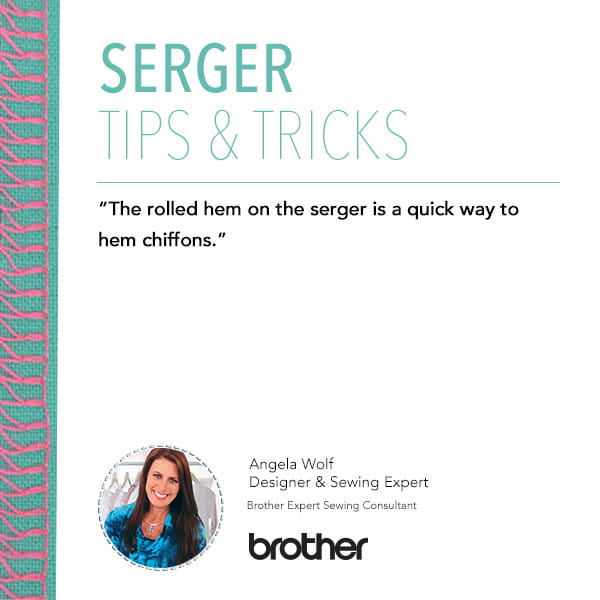Quick Tip: Hemming Chiffon with a Serger

How to hem chiffon
Chiffon fabric is a beautiful material for creating formal wear, bridesmaid dresses, flowing dance costumes, and even wedding dresses.
Whether you prefer nylon or silk chiffon, you’ll love the lightweight transparency and gauzy look you can achieve with this popular sheer fabric.
If you’re new to sewing with delicate, lightweight fabrics like chiffon, tulle, or organza, you may put your sewing skills to the test when you hem a chiffon dress or top.
But we’re here to help! With a bit of practice, the right tools and materials, and our tips, you’ll be hemming chiffon successfully before you know it.
Is it difficult to hem chiffon?
Hemming chiffon is more difficult than creating hems on less delicate fabrics.
While sturdy cottons are easily folded and pressed in place for crisp hems, chiffon fabric can be more slippery and won’t hold its shape as well.
The key to hemming chiffon is understanding how the fabric behaves, what techniques to avoid, and giving yourself plenty of time and excess fabric scraps to practice your sewing techniques.
For the best results, make sure you give your fabric or chiffon garment time to hang so the fabric drops before you start sewing.
How to hem chiffon with a Brother sewing machine
Creating a rolled hem is a great way to hem the raw edge of chiffon with a sewing machine.
We’ll take you through each step so you can take it slow and get a perfect hemline.
What you’ll need to hem chiffon
Before you can start hemming a chiffon prom dress or other garment with your sewing machine, you’ll need to gather a few supplies.
- Brother sewing machine: Any sewing machine with a straight stitch will work.
- Rolled hem foot: A hem presser foot helps you roll the fabric edge over for a consistent hemline.
- Chiffon fabric or garment: Chiffon comes in nylon, polyester, and silk varieties.
- Sharp needles: Sharp, fresh needles are less likely to snag the fabric.
- Thread: It’s a good idea to use thread that’s made of the same material as your chiffon in a similar color for invisible results.
- An iron: You’ll want to press your hem once you finish.
Set up your machine for the rolled hem
Thread your sewing machine and attach the rolled hem foot to your presser foot arm.
Rolled hem feet come in a few different sizes, but narrow rolled hems often look the best for delicate materials like chiffon.
Set your stitch style to a short to medium-length straight stitch.
Sew a line of basting stitches
Using a ¼ inch seam allowance, sew a straight line of basting stitches on the wrong side of the fabric, along the raw edge.
Make sure to leave long thread tails at either end of the stitch row.
Feed the chiffon edge into the rolled hem foot
This can be the trickiest part of the process so take it slow.
Raise your presser foot and use the thread tail to feed the fabric into the rolling guide on the foot. Lower the presser foot to hold everything in place.
When properly fed, the raw edge of the fabric will actually fold over itself twice as you sew.
As long as the fabric is properly aligned within the presser foot, the foot will handle most of the work as you hem.
Sew your rolled hem
As you slowly depress the foot pedal, use your left hand to hold the basting stitch thread tails taut.
Then, use your right hand to hold the raw edge taught so the rolled hem foot can do its job.
Avoid backstitching as it can cause tension issues with the presser foot. Hand stitching a few knots in the tail is a better method to secure your hem.
Press the hem
Lightly iron your new hem to press the fabric and give your hem a more finished look.
Other ideas for hemming chiffon
The rolled hem method isn’t the only option, but it is often the cleanest finished product.
While creating a hem with a serger is sometimes considered the easy way, rolled hems are infinitely more attractive and professional looking for a chiffon garment.
If you don’t have access to a rolled hem foot, you can create a narrow hem by sewing a folded hem with a straight stitch, pressing the hem line flat, then folding it over and sewing another straight line.
Remember, if you’re hemming an existing garment, you’ll have a much smaller margin for error than when working with raw fabric.
It’s also a good idea to practice with your rolled hem foot before you begin sewing on a finished garment.
Elevate your sewing skills by learning to hem chiffon
Are you ready to get started with chiffon?
We know this is one of the trickier skills to learn, but with some practice and the right tools, you’ll be hemming like a pro in no time.
Grab your fabric, fire up that sewing machine, and show that chiffon who's boss!

